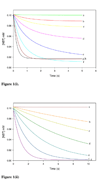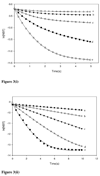Rapid and simple kinetics screening assay for electrophilic dermal sensitizers using nitrobenzenethiol
- PMID: 20402462
- PMCID: PMC2885775
- DOI: 10.1021/tx100003w
Rapid and simple kinetics screening assay for electrophilic dermal sensitizers using nitrobenzenethiol
Abstract
The need for alternatives to animal-based skin sensitization testing has spurred research on the use of in vitro, in silico, and in chemico methods. Glutathione and other select peptides have been used to determine the reactivity of electrophilic allergens to nucleophiles, but these methods are inadequate to accurately measure rapid kinetics observed with many chemical sensitizers. A kinetic spectrophotometric assay involving the reactivity of electrophilic sensitizers to nitrobenzenethiol was evaluated. Stopped-flow techniques and conventional UV spectrophotometric measurements enabled the determination of reaction rates with half-lives ranging from 0.4 ms (benzoquinone) to 46.2 s (ethyl acrylate). Rate constants were measured for seven extreme, five strong, seven moderate, and four weak/nonsensitizers. Seventeen out of the 23 tested chemicals were pseudo-first order, and three were second order. In three out of the 23 chemicals, deviations from first and second order were apparent where the chemicals exhibited complex kinetics whose rates are mixed order. The reaction rates of the electrophiles correlated positively with their EC3 values within the same mechanistic domain. Nonsensitizers such as benzaldehyde, sodium lauryl sulfate, and benzocaine did not react with nitrobenzenethiol. Cyclic anhydrides, select diones, and aromatic aldehydes proved to be false negatives in this assay. The findings from this simple and rapid absorbance model show that for the same mechanistic domain, skin sensitization is driven mainly by electrophilic reactivity. This simple, rapid, and inexpensive absorbance-based method has great potential for use as a preliminary screening tool for skin allergens.
Figures










Similar articles
-
Pyridoxylamine reactivity kinetics as an amine based nucleophile for screening electrophilic dermal sensitizers.Toxicology. 2014 Jan 6;315:102-9. doi: 10.1016/j.tox.2013.11.009. Epub 2013 Dec 12. Toxicology. 2014. PMID: 24333919 Free PMC article.
-
Development of a peptide reactivity assay for screening contact allergens.Toxicol Sci. 2004 Oct;81(2):332-43. doi: 10.1093/toxsci/kfh213. Epub 2004 Jul 14. Toxicol Sci. 2004. PMID: 15254333
-
A fluorescence high throughput screening method for the detection of reactive electrophiles as potential skin sensitizers.Toxicol Appl Pharmacol. 2015 Dec 1;289(2):177-84. doi: 10.1016/j.taap.2015.09.027. Epub 2015 Oct 9. Toxicol Appl Pharmacol. 2015. PMID: 26455772
-
Allergic contact dermatitis--formation, structural requirements, and reactivity of skin sensitizers.Chem Res Toxicol. 2008 Jan;21(1):53-69. doi: 10.1021/tx7002239. Epub 2007 Dec 4. Chem Res Toxicol. 2008. PMID: 18052130 Review.
-
Alternative approaches to the identification and characterization of chemical allergens.Toxicol In Vitro. 2001 Aug-Oct;15(4-5):307-12. doi: 10.1016/s0887-2333(01)00027-3. Toxicol In Vitro. 2001. PMID: 11566554 Review.
Cited by
-
Pyridoxylamine reactivity kinetics as an amine based nucleophile for screening electrophilic dermal sensitizers.Toxicology. 2014 Jan 6;315:102-9. doi: 10.1016/j.tox.2013.11.009. Epub 2013 Dec 12. Toxicology. 2014. PMID: 24333919 Free PMC article.
-
Mechanistic understanding of molecular initiating events (MIEs) using NMR spectroscopy.Toxicol Res (Camb). 2015 Sep 15;5(1):34-44. doi: 10.1039/c5tx00246j. eCollection 2016 Jan 1. Toxicol Res (Camb). 2015. PMID: 30090324 Free PMC article.
-
Reactivity measurement in estimation of benzoquinone and benzoquinone derivatives' allergenicity.Toxicology. 2016 Jan 2;339:34-39. doi: 10.1016/j.tox.2015.11.002. Epub 2015 Dec 2. Toxicology. 2016. PMID: 26612505 Free PMC article.
-
2-Sulfonylpyrimidines as Privileged Warheads for the Development of S. aureus Sortase A Inhibitors.Front Mol Biosci. 2022 Jan 3;8:804970. doi: 10.3389/fmolb.2021.804970. eCollection 2021. Front Mol Biosci. 2022. PMID: 35047562 Free PMC article.
-
The LLNA: A Brief Review of Recent Advances and Limitations.J Allergy (Cairo). 2011;2011:424203. doi: 10.1155/2011/424203. Epub 2011 Jun 16. J Allergy (Cairo). 2011. PMID: 21747867 Free PMC article.
References
-
- Dean JH, Twerdok LE, Tice RR, Sailstad DM, Hattan DG, Stokes WS. ICCVAM evaluation of the murine local lymph node assay. Conclusions and recommendations of an independent scientific peer review panel. Regul. Toxicol. Pharmacol. 2001;34(3):258–273. - PubMed
-
- Buehler EV. Delayed Contact Hypersensitivity in the Guinea Pig. Arch. Dermatol. 1965;91:171–177. - PubMed
-
- Magnusson B, Kligman AM. The identification of contact allergens by animal assay. The guinea pig maximization test. J. Invest Dermatol. 1969;52(3):268–276. - PubMed
-
- Ryan CA, Gerberick GF, Gildea LA, Hulette BC, Betts CJ, Cumberbatch M, Dearman RJ, Kimber I. Interactions of contact allergens with dendritic cells: opportunities and challenges for the development of novel approaches to hazard assessment. Toxicol. Sci. 2005;88(1):4–11. - PubMed
-
- Schultz TW, Carlson RE, Cronin MT, Hermens JL, Johnson R, O'Brien PJ, Roberts DW, Siraki A, Wallace KB, Veith GD. A conceptual framework for predicting the toxicity of reactive chemicals: modeling soft electrophilicity. SAR QSAR Environ. Res. 2006;17(4):413–428. - PubMed
Publication types
MeSH terms
Substances
Grants and funding
LinkOut - more resources
Full Text Sources
Other Literature Sources

